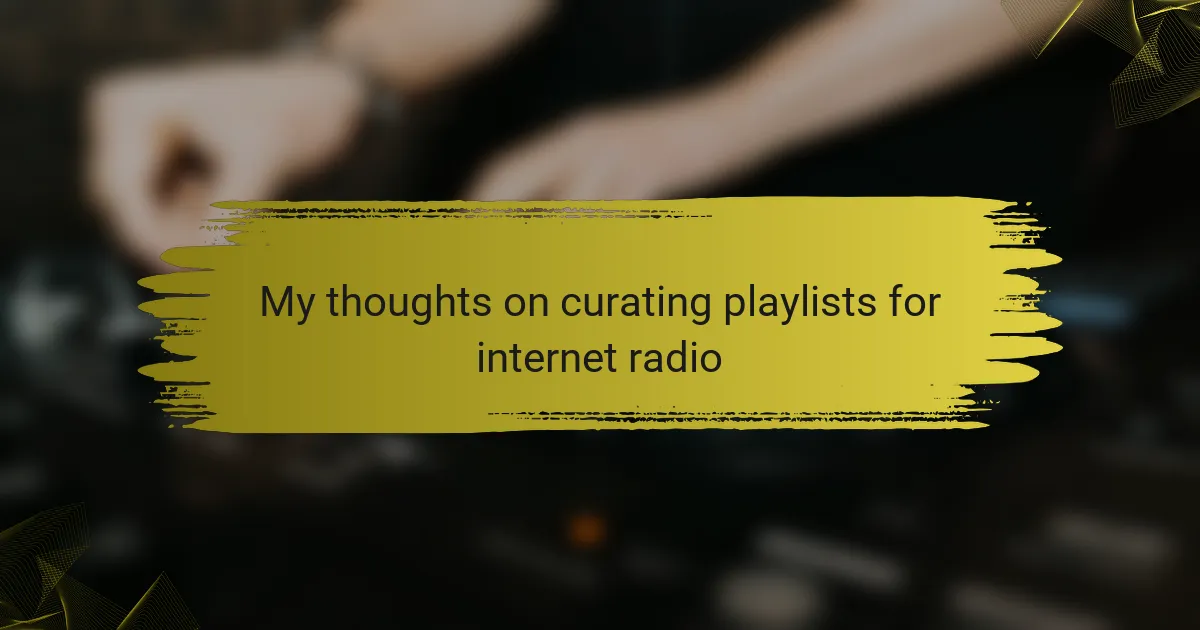Key takeaways
- Independent radio media promotes community engagement and showcases underrepresented voices, fostering a deeper connection with listeners.
- Playlists are essential for creating a unique station identity and enhancing the listener experience through emotional storytelling and genre diversity.
- Effective playlist curation involves understanding audience preferences, mixing familiar and new tracks, and incorporating personal anecdotes to engage listeners.
- Tools like Spotify for Artists and Mixcloud can aid in playlist creation and audience interaction, enhancing the overall curation process.
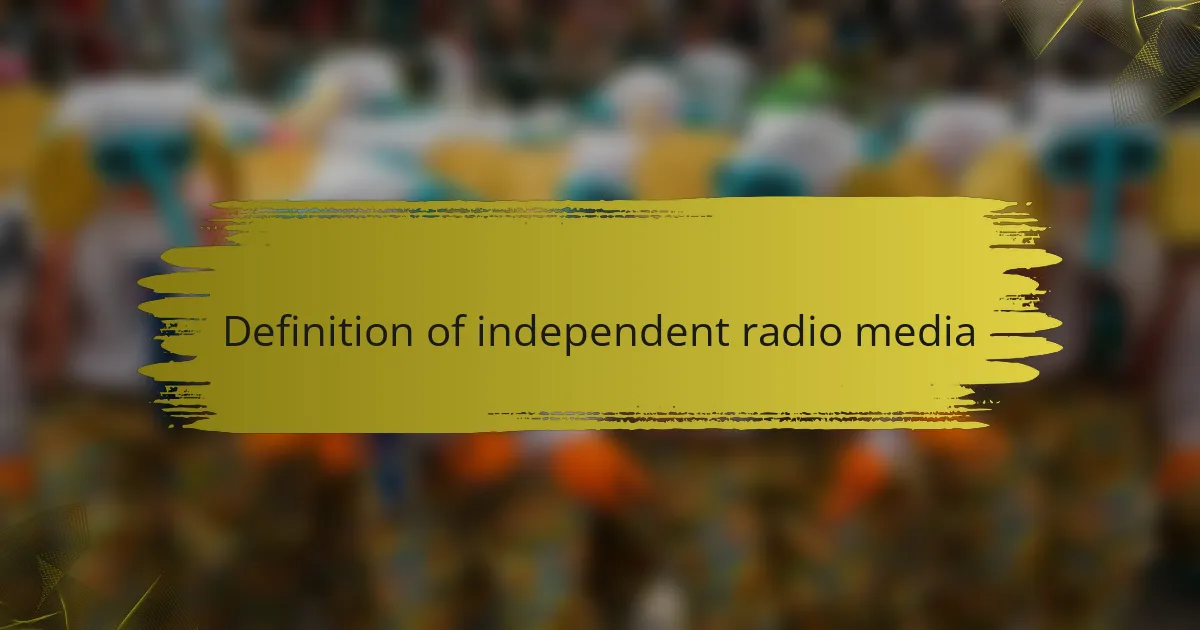
Definition of independent radio media
Independent radio media refers to non-commercial radio stations that operate outside the control of major corporate entities. These stations often emphasize community engagement, diverse programming, and local music, allowing for a more authentic representation of the voices and cultures within a specific area. Isn’t it refreshing to hear content that isn’t just driven by ratings and profit?
For me, independent radio embodies the spirit of creativity and expression. I remember tuning into a local station where the hosts passionately shared stories about their neighborhoods and highlighted up-and-coming artists. It was that genuine connection that made me appreciate how independent radio can foster a sense of belonging and community.
Unlike mainstream media, independent radio gives a platform to underrepresented voices, often tackling social issues and topics that matter deeply to listeners. This form of media isn’t just about entertainment; it’s about sparking conversations and driving change. Have you ever felt that surge of inspiration when listening to something that resonates with your own experiences? That’s the magic of independent radio.
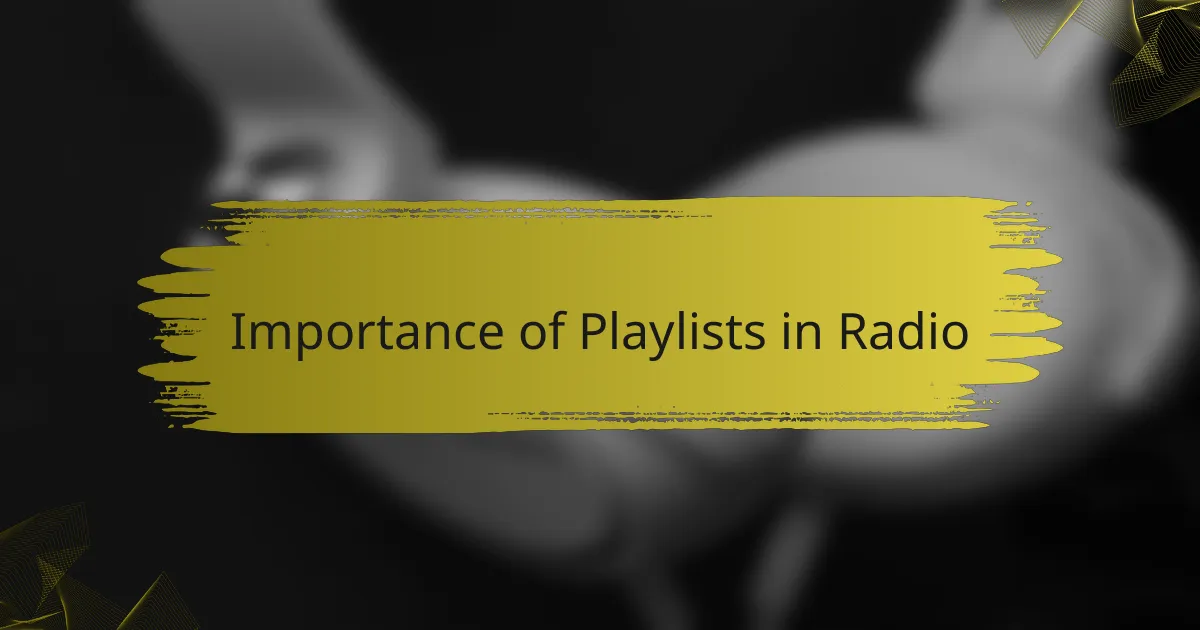
Importance of playlists in radio
Playlists in radio serve as the backbone of a station’s identity, guiding listeners through an emotional and auditory journey. I recall crafting a playlist for a community event where every song told a story, connecting past experiences with the present. It’s fascinating how a well-curated playlist can create a shared experience, making listeners feel like they’re part of something larger.
The importance of playlists extends beyond mere song selection; they shape the mood and atmosphere of a radio show. I often think about how a soothing acoustic track can provide comfort during a tough day or how an upbeat song can elevate someone’s spirits. Curating these moments with intention can turn an average listening experience into something truly memorable.
Moreover, playlists help in building a loyal audience. When listeners hear their favorite songs mixed with fresh, unique tracks, it keeps them coming back for more. Have you ever found a station that consistently plays music you adore? That loyalty is a direct result of thoughtful playlist creation, ensuring every listener feels seen and heard.
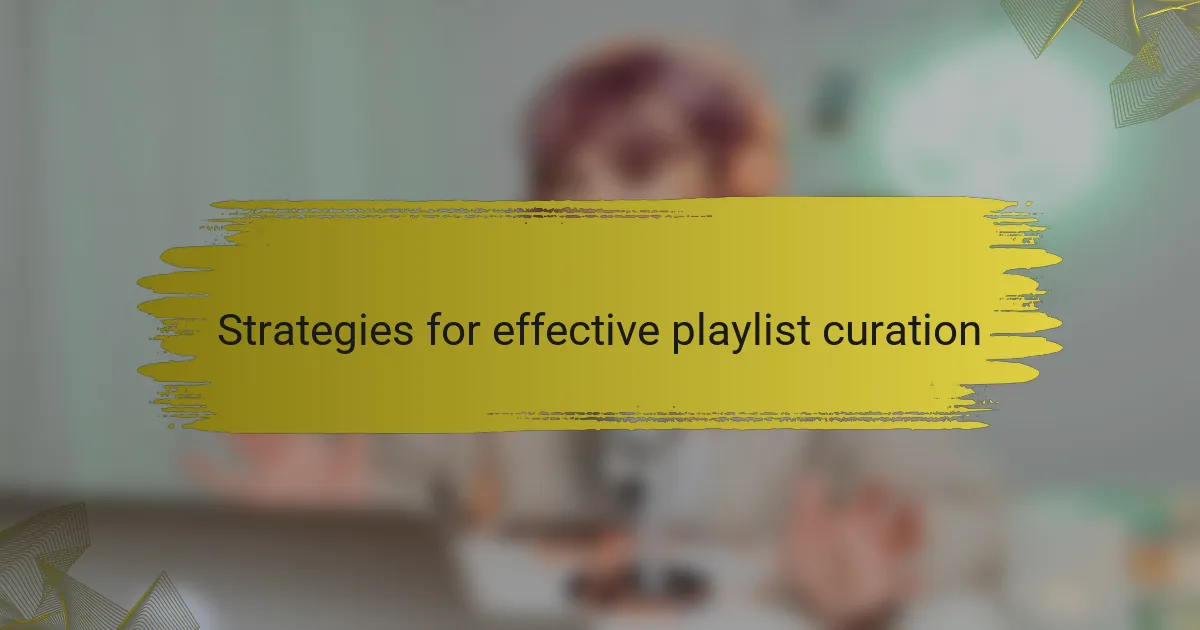
Strategies for effective playlist curation
One effective strategy for playlist curation is to focus on storytelling. Each song can contribute to a narrative arc that resonates with listeners emotionally. I remember putting together a playlist centered around personal growth, where I consciously selected tracks that reflected different stages of overcoming challenges. It was incredible to see how listeners connected with the journey, often sharing their own stories in response.
Balancing familiar tracks with new discoveries is another key tactic. I find that mixing well-known songs with hidden gems keeps the audience engaged and curious. When I introduced an obscure artist alongside popular hits, I noticed listeners becoming explorers, eager to discover the next “favorite” song. There’s something thrilling about sharing those lesser-known tracks that can shift someone’s musical perspective.
Additionally, considering the time of day and listener demographics can greatly enhance the effectiveness of a playlist. For instance, early morning shows might benefit from uplifting tracks to energize listeners, while late-night segments can delve into more introspective music. I often adjust my selections based on feedback, which makes my playlists feel more like a conversation. How do you approach the ever-changing moods of your audience? Addressing these nuances helps your curation feel personal and relevant.
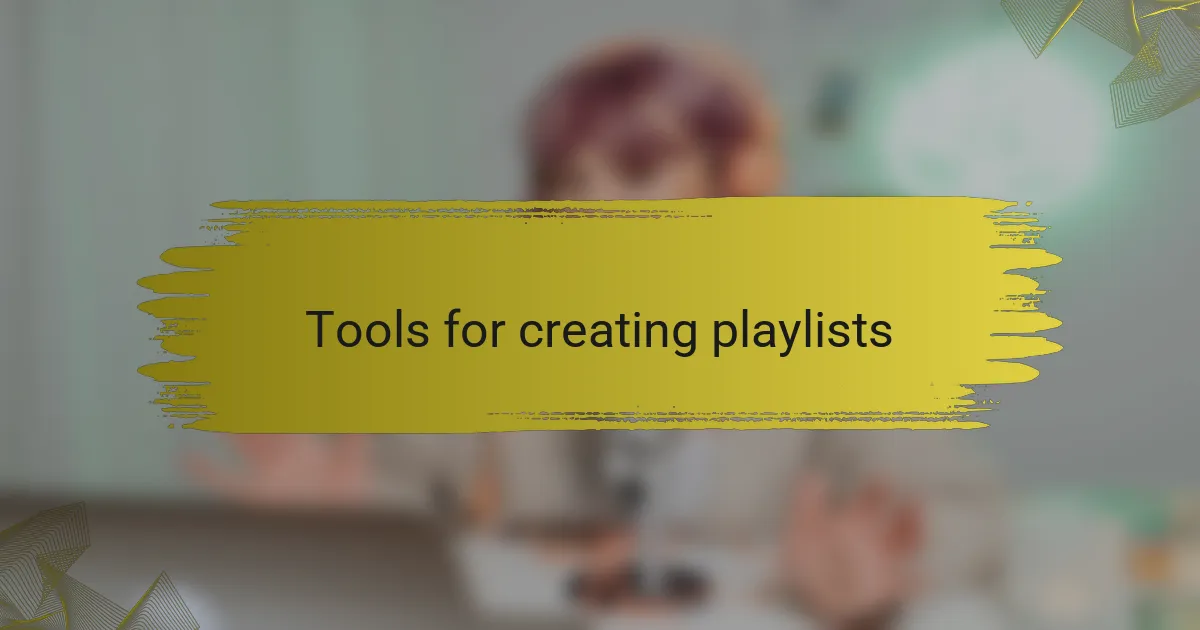
Tools for creating playlists
When it comes to curating playlists for internet radio, having the right tools can make all the difference. I’ve experimented with various music software and found that the ones I enjoy the most not only make the process smoother but also enhance my creative flow. For instance, using tools that allow for easy drag-and-drop playlist creation can save time and keep the focus on the music itself, which is ultimately what it’s all about.
Additionally, I appreciate analytics tools that provide insights into what’s resonating with listeners. It’s gratifying to see which tracks get the most engagement. Knowing that my selections are making a connection truly fuels my passion for curating meaningful playlists.
Here’s a comparison of some popular tools I’ve come across, each with its own strengths and unique features:
| Tool | Features |
|---|---|
| Spotify for Artists | Custom playlists, analytics, audience insights |
| Mixcloud | DJ sets, shows, live-streaming options |
| SoundCloud | Vast library, collaboration features, listener feedback |
| AudioMack | Free uploads, community engagement, interactive playlists |

How to reflect personal taste in playlists
When it comes to curating playlists, reflecting personal taste is crucial. I remember the first time I created a playlist for my internet radio show; it was a blend of my favorite indie rock tracks that told my story. Each song resonated with moments in my life, which made it deeply personal—and that connection definitely came through to my listeners.
To make a playlist truly reflect your unique taste, consider these tips:
- Choose tracks that evoke memories: Think of songs that take you back to significant moments.
- Mix genres: Don’t limit yourself; a variety of styles can create a dynamic listening experience.
- Include emerging artists: Highlight hidden gems that truly speak to your musical preferences.
- Tell a story: Arrange tracks in a way that takes listeners on a journey, reflecting your experiences.
- Stay updated: Regularly refresh your playlist with new music that excites you and represents your evolving taste.
Curating playlists is ultimately about sharing your musical journey, inviting listeners to experience the same emotions and memories that resonate with you.
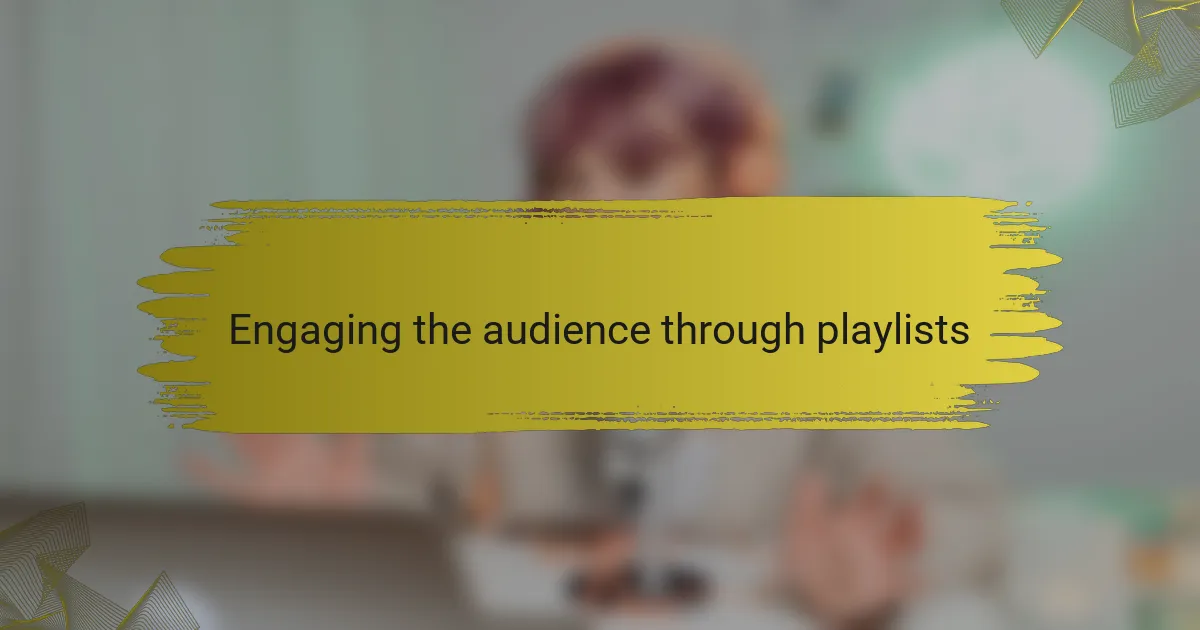
Engaging the audience through playlists
Creating compelling playlists for internet radio is more than just selecting songs; it’s about building a connection with your audience. I’ve often found that a well-curated playlist can evoke memories or inspire emotions, transforming how listeners experience music. For instance, I once crafted a themed playlist around summer nostalgia, which brought back memories for many listeners—people shared stories about their childhood summers, and it created a beautiful sense of community.
Engaging your audience through playlists involves knowing their tastes and tapping into the emotions they experience while listening. Additionally, I think about the flow of the playlist; it should tell a story that resonates with listeners. Here are a few ways to ensure your playlists do just that:
- Understand your audience: Research their preferences and actively seek feedback after each show.
- Curate with intent: Each song should fit a theme or mood, creating a cohesive listening experience.
- Include personal touches: Share anecdotes or stories about why you chose certain tracks—this fosters intimacy.
- Diversity matters: Mix genres and styles to keep the audience intrigued and encourage exploration of new sounds.
- Engage with real-time feedback: Use social media to sense the emotions and reactions of your listeners during broadcasts.
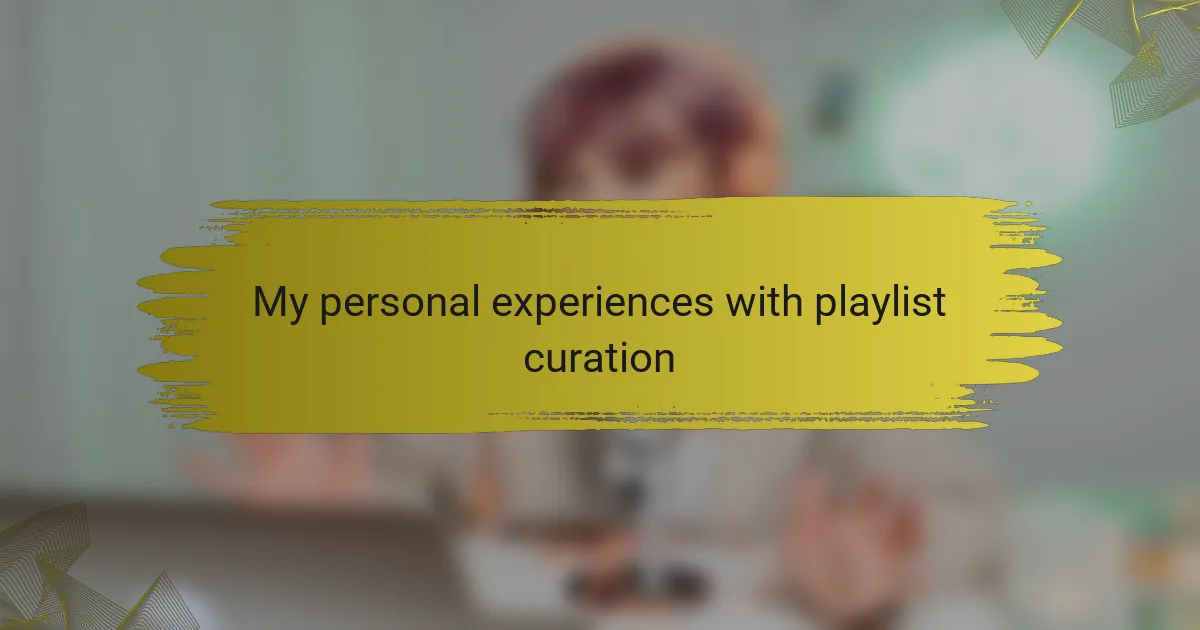
My personal experiences with playlist curation
Curating playlists for internet radio has been a rewarding experience for me. I remember my first attempt at creating a playlist; it felt like crafting a story. Each song had to flow seamlessly into the next, capturing the listener’s mood and taking them on a journey, which was both thrilling and daunting.
One thing I’ve learned is the importance of diversity in music selection. I always strive to include a range of genres and artists. This not only keeps the playlist interesting but also introduces listeners to new sounds that they might love. I still recall the joy on a listener’s face when they discovered a new favorite song through one of my curated sets.
Another aspect that stands out is the balance between popular hits and hidden gems. While it’s tempting to lean heavily on well-known tracks, I’ve enjoyed showcasing indie artists and lesser-known songs. It creates a unique atmosphere that feels personal and intimate, much like an old friend sharing their favorite tracks.
| Aspect | My Approach |
|---|---|
| Diversity | Incorporate various genres and styles. |
| Listener Engagement | Focus on songs that evoke emotion and connection. |
| Mix of Well-Known and Indie | Ensure a balance to create interest. |
